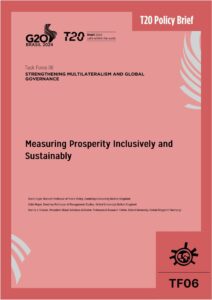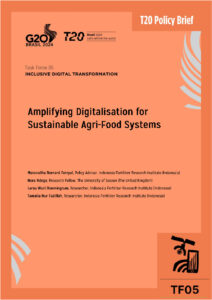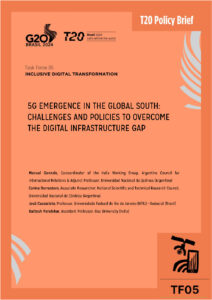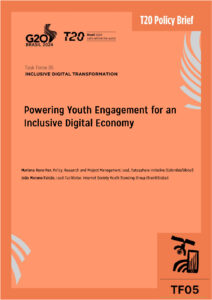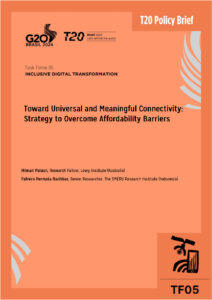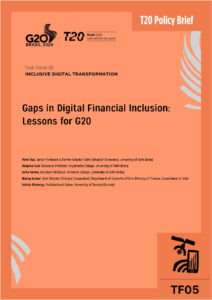Pollution is the single largest environmental risk factor for premature death globally. It is a major driver of climate change. It is also a significant contributing factor to the severity of the COVID-19 pandemic, and a burden on economic growth. It is cutting short the lives and potential of generations of children, exacerbating the cycle of poverty, and is a cause of social injustice. The intersection of pollution and health, climate change, and economic growth, and the rapid pace at which results can be felt and measured, make pollution mitigation a valuable and powerful G20 opportunity for action. As we “build back better” post-COVID-19, G20 countries should work to minimize the adverse health and economic outcomes of global pandemics by committing to ensuring clean air, water, and soil for all.
Challenge
Although pollution is the single largest environmental risk factor for premature death globally, a contributor to the severity of the COVID19 pandemic, and a major driver of climate change, the co-benefits of targeting pollution are not currently being realized on a global or national scale.
Pollution—unwanted, often dangerous material that is introduced into the environment through human activity—has serious consequences for human and environmental health. Diseases caused by all forms of pollution, such as cancers, chronic obstructive pulmonary disease, and cardiovascular disease, were responsible for an estimated 8 million deaths in 2017 (Landrigan et al. 2018; Fuller, Sandilya, and Hanrahan 2019). Air pollution is the most serious contributor to premature deaths. Deaths from ambient air pollution range between 3.0 million (Health Effects Institute 2019) and 4.2 million (WHO 2015) per year. Household air pollution—produced by solid fuel-burning stoves for heating and cooking—is responsible for an additional 2.9–4.3 million deaths per year (Landrigan et al. 2018). Around 92% of the impact is on low- and middle-income countries (Landrigan et al. 2018). About 91% of the world’s population lives in places with unhealthy air (WHO 2020a). There is growing evidence that air pollution is a key contributor to the severity of the COVID-19 pandemic, including in G20 countries such as Italy and the United States (Isaifan 2020; Ogen 2020).[1]
A 2019 ranking of global premature pollution-related deaths placed six G20 countries— India, China, Indonesia, the United States, Russia, and Brazil—in the top 10, with a combined death toll of over 4.8 million people per year (Figure 1; Fuller, Sandilya, and Hanrahan 2019).

The burning of fossil fuels and biomass for heating, electricity generation, transport, and agriculture/land use is the world’s largest source of both carbon dioxide and disease-causing particulate matter (Global Alliance on Health and Pollution 2020; Schmidt 2011; Cassou 2018). G20 countries are responsible for approximately 75% of all global CO2 emissions (Union of Concerned Scientists 2020). Agricultural burning alone is responsible for nearly 40% of global black carbon emissions, which can contribute to direct warming of the atmosphere by absorbing incoming solar radiation (Schmidt 2011; Cassou 2018).
Fine particulate matter (PM2.5) poses the biggest risk to human health, reducing lung function, damaging the immune system, and increasing risk of contracting pneumonia and other respiratory infections, including COVID-19 (European Public Health Alliance 2020; Kurt, Zhang, and Pinkerton 2016).
The economic costs of poor pollution management are significant. The 2017 Lancet Commission on Pollution and Health determined that pollution reduces annual Gross Domestic Product (GDP) in low- and middle-income countries by up to 2%. In rapidly developing countries, treatment of pollution-related diseases accounts for up to 7% of total annual healthcare costs (Landrigan et al. 2018). The World Bank estimates that
air pollution cost $21 billion in global health care expenditures in 2015 alone (World Bank and Institute for Health Metrics and Evaluation 2016).
Women, children, marginalized communities, and the poor are most vulnerable and are disproportionately affected by pollution-related diseases and mortality, making pollution both a cause and effect of social injustice. Heavy metals, such as lead, and other chemicals can be stored long-term in the body and then transmitted to a fetus in-utero and via breast milk (Pajewska-Szmyt, Sinkiewicz-Darol, and Gadzała-Kopciuch 2019). Exposure can exacerbate other health concerns, trigger long-term illness, cause permanent neurological damage, and lower IQs, not only in young women but also in their future children (Palmieri et al. 2019). Additionally, socioeconomic factors cause further pollution risks. Women and minorities are commonly pushed to the fringe in many industries. They are excluded from health trainings, formal job protections, and health benefits, thereby forming a de facto high-risk population (Tibuakuu et al. 2018).
Despite these enormous costs, pollution has not received adequate international attention or resources, and the issue of pollution and its impact on health has been overlooked in the G20 agenda[2] Abatement efforts remain severely under-resourced, including in G20 countries. This is particularly the case for pollution stemming from industrialization and urbanization, including ambient air pollution and chemical and heavy metal contamination. China and India have taken the lead by declaring a “War on Pollution,” pledging billions and millions of funding, respectively (Saikawa 2019). Multilateral environmental agreements, such as the Paris Climate Accord, the Convention on Long-Range Transboundary Air Pollution, and the Basel Convention on Transboundary Hazardous Waste, are a step in the right direction. So are the 2015 G20 Energy Action Plan and the 2017 Hamburg Summit commitments to clean oceans and clean water.
However, none of these agreements prioritize addressing pollution according to human health impacts, and all are insufficient to tackle the enormity of the problem. This is mirrored in donor responses as well. Pollution stemming from industrialization and urbanization receives 10 times less funding per death ($14/death) than funding for HIV/AIDS or tuberculosis and 90 times less than malaria (Swinehart et al. 2019). The lack of attention to this matter in the G20 agenda is both a glaring lacuna and a missed opportunity. When implemented, pollution control measures provide high returns on investment. The WHO (2020b) estimates that meeting the Paris Agreement targets will save 1 million lives per year due to resulting reductions in air pollution. The value of those gains would be double the costs of mitigation. Other studies show that every ton of CO2 emissions abated helps to avoid $50–$100 of PM2.5 damages in most G20 countries (Hamilton 2017). China’s efforts to mitigate urban air pollution from 2014–2018 reduced PM2.5 by 32%, extending average lifespans for residents by 2.4 years (Greenstone 2018). In the US, every $1 spent on air quality control since 1970 has yielded roughly $30 in benefits—a total benefit of $1.5 trillion compared to a $65 billion investment (Greenstone 2018). Figure 2 summarizes additional key global success stories.

Proposal
The intersection of pollution with health, climate change, and economic growth and the rapid pace at which results can be seen, felt, and measured make pollution mitigation a valuable policy target.
Pollution-mitigation efforts can improve health in the short- and long-term while reducing climate-driving emissions. There is a strong body of evidence demonstrating that respiratory symptoms, school absenteeism, clinic visits, hospitalizations, premature births, cardiovascular illness, and death can decrease significantly within weeks of implementing pollution-mitigation policies (Schraufnagel et al. 2019; Manju et al. 2018). This is especially important in the context of COVID-19. Addressing pollution likewise has spillover effects on national security, reducing population displacement (Mastor et al. 2018) and violence (Wright et al. 2008; Lanphear 2017). Additionally, taking immediate steps to address air, water, and soil pollution can mitigate unexpected impacts from extreme climate and weather events and disasters—principally droughts and floods. Such events can spread contaminated dust, soil, and water, affecting communities far from the source of pollution.
When pollution stops, clean skies are immediately noticeable. This was a highly visible, unintended result of fighting the COVID-19 crisis: within days of closing local economies, many citizens experienced clean air and smog-free blue skies for the first time in a generation. However, economies do not need to be stopped or slowed down to clean up pollution. Public support for green policies is strong and growing[3] —all citizens want and deserve clean air, water, and soil.
Priority recommendation: As we build back better post-COVID-19, G20 countries should work to minimize the adverse health and economic outcomes of global pandemics by committing to ensuring clean air, water, and soil for all.
If the below policies and solutions are implemented, G20 countries can hope to eliminate a significant percentage of global CO2 emissions, save hundreds of thousands of lives, boost economic growth, and help mitigate the impacts of future global pandemics and disasters (Nikolewski 2020; Climate and Clean Air Coalition 2020).
Priority 1: G20 leaders should commit to reducing fine particulate matter (PM2.5) concentrations by at least 25% by 2030 in the G20 2020 Communique and in the G20 Health Ministers Commitments.
All G20 countries should “level the playing field” in their own countries. They must rapidly phase out incentives to polluting industries, increase pollution fines to levels that will change behavior and industry practices, and implement cost-effective pollution and climate change mitigation strategies, with aggressive targets and timetables. They should also ensure investment and training in effective law enforcement.
When combined with strong political will, these measures would improve health, reduce climate change-driving emissions, and create funds that can be used to offset implementation costs. G20 countries, cities, and local governments should join the Powering Past Coal Alliance. Wealthier nations can use generated funds or reallocate savings to a variety of supportive policies. This includes government-sponsored green jobs, expanding consumer and business incentives to adopt greener technologies and practices, incentives for renewable energy sectors, and research and development for sustainable technology. These “market-correcting” policy changes can pave the way for next steps.
There are several solutions countries can implement to reduce both CO2 equivalents and PM2.5. The following are the relatively easiest, most feasible, and effective measures to improve health and economic growth and reduce climate changedriving emissions (Global Alliance on Health and Pollution 2020):
- Electrifying public transportation systems
- Implementing cleaner fuels for public transportation systems
- Reducing sulfur content in diesel fuels
The need for clean energy extends to energy storage, as well. As the market for traditional and electric vehicles and solar energy grows, so will demand for the lead acid batteries that help power them. These batteries, when unsafely recycled, poison millions of people each year (Landrigan et al. 2018, UNICEF and Pure Earth, 2020). Solutions that have a larger impact on health and emissions reductions but require more up-front investment and a longer timeframe for implementation include:
- Replacing coal-fired power plants with renewable energy sources
- Replacing coal-fired power plants with natural gas
- Eliminating uncontrolled diesel emissions
- Preventing crop-residue burning and forest fires
- Implementing cleaner household fuels
The relative benefits of each of these solutions are presented in Figure 3.

Priority 2: G20 countries should prioritize, mainstream, and fund pollution prevention and mitigation nationally and internationally.
As pollution cross-cuts a wide range of sectors, effective mitigation strategies require collaboration between and among government agencies, the private sector, and civil society. In many countries, responsibility for environmental pollution and climate issues rests with the Ministry of Environment, yet pollution-related disease is the purview of the Ministry of Health. Air, water, soil, and chemical pollution are likewise often siloed— they are regulated by different agencies and studied by different research groups. The consequence is that the full scale of pollution and its contribution to national and global burdens of disease and economic losses are not recognized.
G20 countries should facilitate regular inter-ministerial exchange of evidence and science-based knowledge in the fields of pollution and health.
G20 health and environment ministers should begin meeting regularly to share experiences and best practices to support their respective governments to address pollution and health problems. G20 leaders should also advocate for action on pollution prevention and mitigation in discussions around One Health.
G20 countries should integrate pollution and health planning into country and city planning processes, including nationally determined contributions. This can be done through holistic approaches to transport, infrastructure, urban planning, food production, health, industry, and construction that aim to reduce emissions and pollutants while protecting jobs (or planning for transitioning workers to green jobs). India, China, and several non-G20 countries, including Madagascar, Thailand, and the Philippines, have already begun this process (Saikawa 2019; Greenstone and Fan 2019; Jaiswal 2019).[4] Institutions such as the Global Alliance on Health and Pollution and the Climate and Clean Air Coalition stand ready to support G20 and other countries in their efforts.
As pollution is a transboundary issue affecting countries worldwide, there is a strong need to advocate for increased international funding targeting the pollution, climate, and health nexus. Lower- and middle-income countries vary in their capacity to respond to pollution problems. Increasing aid allocation to the pollution, climate, and health nexus, or to pollution and health more broadly, will allow more countries to access financial and technical resources. They can then build their capacity to tackle this issue effectively.
G20 donor countries should increase aid and development financing for pollution prevention and control, especially to countries willing to take aggressive action to dramatically cut emissions and contribute to improved health and economic growth. Funding must also be allocated to establish or scale-up rigorous, robust, and transparent systems and metrics to monitor pollution and its health impacts. Lack of data and cohesive data management and sharing platforms are key barriers to the development of effective pollution-mitigation strategies. Enhanced monitoring will enable countries to document pollution problems, track progress, and prioritize investments based on returns for health, the environment, and economic growth. Strong data collection and monitoring networks can be leveraged between countries and regions to learn from each other’s best practices, enhancing efficiency and building capacity and collaboration. G20 and non-G20 countries must take advantage of technological advances such as low-cost sensors and open-source computational packages to enhance the feasibility, reliability, and cost-effectiveness of pollution monitoring.
Key Recommendations
- G20 countries should work to minimize the adverse health and economic outcomes of global pandemics and “build back better” by committing to ensuring clean air, water, and soil for all.
- G20 leaders should commit to reducing fine particulate matter (PM2.5) concentrations by at least 25% by 2030 in the G20 2020 Communique and the G20 Health Ministers Commitments.
- G20 countries should facilitate regular inter-ministerial exchange of best practices and science-based knowledge pertaining to pollution and health.
- G20 countries should prioritize, mainstream, and fund pollution prevention and mitigation nationally and internationally.
- G20 countries should integrate pollution and health planning into country and city planning processes, including nationally determined contributions, through holistic approaches to transport, infrastructure, urban planning, food production, health, industry, and construction.
- G20 countries must rapidly phase out incentives for polluting industries, with aggressive targets and timetables, ensuring investment and training in effective law enforcement.
Disclaimer
This policy brief was developed and written by the authors and has undergone a peer review process. The views and opinions expressed in this policy brief are those of the authors and do not necessarily reflect the official policy or position of the authors’ organizations or the T20 Secretariat.
References
Cassou, Emilie. 2018. Field Burning. Agricultural Pollution. Washington, DC: World Bank. https://openknowledge.worldbank.org/handle/10986/29504
Clean Air Fund. 2020. “Breathing Space: Why and How We Must Build Back Better To Achieve Clean Air For All.” Clean Air Fund website, briefing paper. https://ncdalliance.org/sites/default/files/resource_files/Clean%20Air%20Now_WebVersion_1.pdf
Climate and Clean Air Coalition. 2020. “Open Agricultural Burning: Promoting No-Burn Alternatives to Reduce Black Carbon Emissions.” Accessed May 20, 2020. https://ccacoalition.org/en/activity/open-agricultural-burning
Conticini, Edoardo, Bruno Frediani, and Dario Caro. 2020. “Can Atmospheric Pollution be Considered a Co-Factor in Extremely High Level of SARS-CoV-2 Lethality in Northern Italy?” Environmental Pollution 261: 114465. https://dx.doi.org/10.1016%2Fj.envpol.2020.114465
European Public Health Alliance. 2020. “Coronavirus Threat Greater for Polluted Cities.” https://epha.org/coronavirus-threat-greater-for-polluted-cities
Fuller, Richard, Karti Sandilya, and David Hanrahan. 2019. Pollution and Health Metrics: Global, Regional, and Country Analysis. Global Alliance on Health and Pollution. https://gahp.net/wp-content/uploads/2019/12/PollutionandHealthMetricsfinal-12_18_2019.pdf
Global Alliance on Health and Pollution 2020. Air Pollution Interventions:
Climate and Health Impacts. https://gahp.net/wp-content/uploads/2020/06/AirPollutionReport_6_22_Final.pdf
Greenstone, Michael. 2018. “Four Years After Declaring War on Pollution, China is Winning.” New York Times, March 12, 2018. https://www.nytimes.com/2018/03/12/upshot/china-pollution-environment-longer-lives.html
Greenstone, Michael and Qing (Claire) Fan. 2019. The Potential Benefits of India’s ‘War Against Pollution’: Longer Lives. Chicago: Energy Policy Institute at the University of Chicago. https://aqli.epic.uchicago.edu/wp-content/uploads/2019/01/The-Potential-Benefits-of-Indias-War-on-Pollution-Longer-Lives.pdf
Hamilton, Kirk. 2017. “Economic Co-Benefits of Reducing CO2 Emissions Outweigh the Cost of Mitigation for Most Big Emitters.” Grantham Research Institute on Climate Change and the Environment, November 3, 2017. https://www.lse.ac.uk/GranthamInstitute/news/economic-co-benefits-of-reducing-co2-emissionsoutweigh-the-cost-of-mitigation-for-most-big-emitters
Health Effects Institute. 2019. State of Global Air 2019. Boston: Health Effects Institute. https://www.stateofglobalair.org/report.
Isaifan, Rima. 2020. “The Dramatic Impact of Coronavirus Outbreak on Air Quality: Has It Saved as Much as It Has Killed So Far?” Global Journal of Environmental Science and Management 6, no. 3: 275–288. https://dx.doi.org/10.22034/gjesm.2020.03.01
Jaiswal, Anjali. 2019. “India Launches a National Clean Air Program.” Natural Resources Defense Council, January 18, 2019. https://www.nrdc.org/experts/anjali-jaiswal/indialaunches-national-clean-air-program
Kurt, Ozlem Kar, Jingjing Zhang, and Kent E. Pinkerton. 2016. “Pulmonary Health Effects of Air Pollution.” Current Opinion in Pulmonary Medicine 22, no. 2: 138–143. https://doi.org/10.1097/mcp.0000000000000248
Lanphear, Bruce. 2017. “Still Treating Lead Poisoning After All These Years.” Pediatrics 140, no. 2: e20171400. https://doi.org/10.1542/peds.2017-1400
Landrigan, Philip J., Richard Fuller, Nereus J.R. Acosta, Olusoji Adeyi, Robert Arnold, Niladri Nil Basu, Abdoulaye Bibi Baldé, et al. 2018. “The Lancet Commission on Pollution and Health.” The Lancet 391, no. 10119: 462–512. https://doi.org/10.1016/s0140-6736(17)32345-0
Manju, A., K. Kalaiselvi, V. Dhananjayan, M. Palanivel, G.S. Banupriya, M.H. Vidhya, K. Panjakumar, and B. Ravichandran. 2018. “Spatio-Seasonal Variation in Ambient Air Pollutants and Influence of Meteorological Factors in Coimbatore, Southern India.” Air Quality, Atmosphere & Health 11: 1179–1189; https://doi.org/10.1007/s11869-018-0617-x
Mastor, Roxana A., Michael H. Dworkin, Mackenzie L. Landa, and Emily Duff. 2018. “Energy Justice and Climate-Refugees.” Energy Law Journal 39: 139–152.
NCD Alliance. 2019. Clean Air Now: Rapid Solutions to the Air Pollution Emergency.
NCD Alliance website, PDF. https://ncdalliance.org/sites/default/files/resource_files/Clean%20Air%20Now_WebVersion_1.pdf
Nikolewski, Rob. 2020. “Closing Coal Plants Alone Will Save Tens of Thousands of Lives, Study Shows.” Los Angeles Times, January 20, 2020. https://www.latimes.com/environment/story/2020-01-20/closing-of-us-coal-power-plants-has-saved-lives
Ogen, Yaron. 2020. “Assessing Nitrogen Dioxide (NO2) Levels as a Contributing Factor to Coronavirus (COVID-19) Fatality.” Science of the Total Environment 726: 138605 https://doi.org/10.1016/j.scitotenv.2020.138605
Pajewska-Szmyt, Martyna, Elena Sinkiewicz-Darol, and Renata Gadzała-Kopciuch. 2019. “The Impact of Environmental Pollution on the Quality of Mother’s Milk.” Environmental Science Pollution Research 26: 7405–7427. https://doi.org/10.1007/s11356-019-04141-1.
Palmieri, James R., Susan Meacham, Jessica Brunette, Tyler Miluski, Sundeep Dhanju, and Sumira Stein. 2019. “Effects of Heavy Metal and Organic Contaminants During Pregnancy and Lactation on Child Health.” Journal of Clinical Case Reports and Trials 2, no. 2: 26–34.
Saikawa, Eric. 2019. “China’s Continued War on Air Pollution.” China Research Center 18, no. 1.
Schmidt, Charles W. 2011. “Black Carbon: The Dark Horse of Climate Change Drivers.” Environmental Health Perspectives 119, no. 4: A172–A175. https://doi.org/10.1289/ehp.119-a172
Sengupta, Somini. 2020. “In 5 Countries, Overwhelming Majorities Want Cleaner Air, Poll Finds.” New York Times article. June 17, 2020. https://www.nytimes.com/2020/06/17/climate/air-pollution-opinion-survey.html
Swinehart, Stephanie, Richard Fuller, Rachael Kupka, and Marc N. Conte. 2019. “Rethinking Aid Allocation: Analysis of Official Development Spending on Modern Pollution Reduction.” Annals of Global Health 85 no. 1: 132. https://doi.org/10.5334/aogh.2633
Tibuakuu, Martin, Erin D. Michos, Ana Navas-Acien, and Miranda R. Jones. 2018. “Air Pollution and Cardiovascular Disease: A Focus on Vulnerable Populations Worldwide.” Current Epidemiology Reports, 5, no. 4: 370–378. https://dx.doi.org/10.1007%2Fs40471-018-0166-8
Schraufnagel, Dean E., John R. Balmes, Sara De Matteis, Barbara Hoffman, Woo Jin Kim, Rogelio Perez-Padilla, Mary Rice et al. 2019. “Health Benefits of Air Pollution Reduction.” Annals of the American Thoracic Society 16, no. 12: 1478–1487. https://doi.org/10.1513/annalsats.201907-538cme
UNICEF and Pure Earth. 2020. The Toxic Truth: Children’s exposure to lead pollution undermines a generation of future potential. Available at: https://www.unicef.org/reports/toxic-truth-childrens-exposure-to-lead-pollution-2020
Union of Concerned Scientists. 2020. “Share of CO2 Emissions by Country.” Last modified May 11, 2020. https://www.ucsusa.org/resources/each-countrys-share-co2-emissions
World Bank and Institute for Health Metrics and Evaluation. 2016. The Cost of Air Pollution: Strengthening the Economic Case for Action. Washington, D.C.: World Bank Group. https://documents.worldbank.org/curated/en/781521473177013155/Thecost-of-air-pollution-strengthening-the-economic-case-for-action
World Health Organization (WHO). 2015. Reducing Global Health Risks through Mitigation of Short-Lived Climate Pollutants. Geneva: World Health Organization. https://www.who.int/phe/publications/climate-reducing-health-risks/en
WHO. 2020a. “Air Pollution.” Accessed June 2, 2020. https://www.who.int/healthtopics/air-pollution#tab=tab_1
WHO. 2020b. Climate Change and Human Health. Accessed June 2, 2020 . https://www.who.int/globalchange/commit/commit-to-ambitious-climate-actio/en/#:~:text=The%20latest%20evidence%20shows%20that,twice%20the%20costs%20of%20mitigation
Wright, John Paul, Kim N. Dietrich, M. Douglas Ris, Richard W. Hornung, Stephanie D. Wessel, Bruce P. Lanphear, Mona Ho, and Mary N. Rae. 2008. “Association of Prenatal and Childhood Blood Lead Concentrations with Criminal Arrests in Early Adulthood.” PLoS Med 5, no. 5: e101. https://doi.org/10.1371/journal.pmed.0050101
Appendix
[1] . Evidence suggests that exposure to pollution increases risk for severe COVID-19 symptoms and death. The risks of complicated COVID-19 symptoms and need for hospitalization and intensive care increases if a patient has underlying health conditions, such as asthma, respiratory problems, a weakened immune system, diabetes, cancer, or other conditions (https://www.cdc.gov/coronavirus/2019-ncov/need-extra-precautions/people-at-higher-risk.html). Pollution is a major risk factor for many of these underlying conditions (European Public Health Alliance 2020). Exposure to air pollution in particular reduces lung function, increases risk of getting pneumonia and other respiratory infections, increases asthma rates, and damag es immune systems (Kurt, Zhang, and Pinkerton 2016; Conticini, Frediani, and Caro 2020).
[2] . Modern pollution and its impacts on health have not been referenced specifically or in any meaningful way in any recent G20 Communiques. Pollution has only been broadly included in generic blanket state ments referring to health, climate, environment, or noncommunicable diseases.
[3] . At least two-thirds of citizens in diverse locations around the world—Great Britain, India, Nigeria, Poland, and Bulgaria—support stricter regulation to tackle air pollution (Clean Air 2020). In most of these coun tries, support is significantly higher (Sengupta 2020).
[4] . Seven low- and middle-income countries have completed and validated Health and Pollution Action Plans (HPAPs), three are underway, and dozens have requested GAHP’s support to develop HPAPs. HPAPs bring together multiple ministries, and stakeholders form public, private, and academic/non-profit/civil society sectors to identify, prioritize, and plan to address pollution problems. More information can be found at: https://gahp.net/hpap-countries



